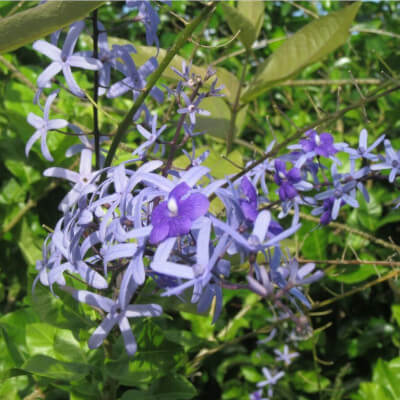
Petrea volubilis, commonly known as the Queen’s Wreath or Sandpaper Vine, is a striking tropical climber, celebrated for its profuse and dazzling blooms. Native to the warm, humid regions of Central America and the Caribbean, this ornamental plant thrives in hot climates. At the botanical garden of Au Bois Vert in Ivato, just outside Antananarivo, it delights visitors with its cascading clusters of violet and blue flowers. These star-shaped blossoms, grouped in showy inflorescences, offer a spectacular visual display that captivates the eye from the very first glance.
This vigorous and long-lived climber can reach heights of up to 12 metres when given the support of pergolas, trellises or trees. Its deep green, oval-shaped leaves are tough and textured—hence the name “sandpaper vine”—and provide a rich backdrop to its vibrant floral show. While it tends to flower most abundantly in the warmer months, under ideal conditions it can bloom almost year-round, making it a highly rewarding plant in tropical gardens.
At Au Bois Vert’s botanical garden, the Queen’s Wreath is far more than a decorative element. It stands as a symbol of tropical biodiversity and reflects the site’s dedication to protecting and showcasing botanical richness. Guests strolling through the garden, or enjoying a meal at the restaurant or a stay at the lodge, often pause to admire this plant, which contributes to the garden’s lush, immersive atmosphere. With its climbing habit, it’s particularly well-suited for covering walls and pergolas, where it offers both beauty and welcome shade.
Its exotic charm, ease of care and ability to attract pollinators make Petrea volubilis a must-have for tropical plant enthusiasts. Whether you’re a keen gardener or simply a curious visitor exploring the botanical garden in Antananarivo, this plant leaves a lasting impression with its colour, form and vitality.
Plant use
Petrea volubilis, commonly known as the Queen’s Wreath or Sandpaper Vine, is above all an ornamental plant prized for both its beauty and practical benefits. Its vigorous climbing habit and rapid growth make it an ideal choice for enhancing and shading outdoor spaces. In places such as hotels, restaurants, and lodges in Ivato, it is frequently used to adorn terraces and pergolas, lending a refined tropical charm. At the Au Bois Vert Botanical Garden, it serves as a striking feature that captures the attention of visitors and immerses them in a lush, vibrant setting. Beyond its decorative appeal, the Queen’s Wreath also plays an important ecological role. Its nectar-rich flowers attract bees, butterflies, and birds, thereby encouraging local pollination and supporting biodiversity. It can also act as a natural screen, providing privacy or serving as a windbreak in more exposed areas. In some local traditions, Petrea volubilis is believed to have medicinal properties. Its leaves and roots are sometimes used in traditional remedies to treat minor ailments, although these uses remain largely undocumented in scientific literature. Resilient to disease and well-suited to humid tropical climates, the plant is relatively easy to maintain. With moderate watering and regular pruning, it continues to bloom year after year, adding lasting beauty to gardens and green spaces. At the Antananarivo Botanical Garden, this plant stands as a perfect example of how nature and culture can coexist in harmony. Whether tucked away in a quiet restaurant corner or featured in the landscaped grounds of a lodge, Petrea volubilis brings a unique and enchanting character to any setting.
Key information
| Common name | Queen’s Wreath |
| Scientific name | Petrea volubilis |
| Origin | Central America, Caribbean |
| Natural habitat | Humid tropical regions |
| Life cycle | Perennial |
| Flowering period | All year round in hot climates, especially in summer |


